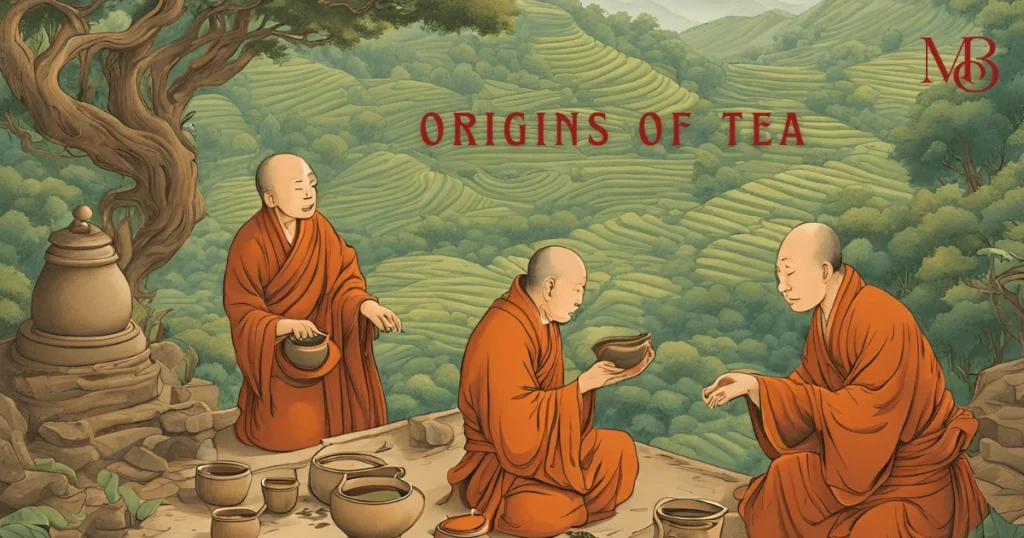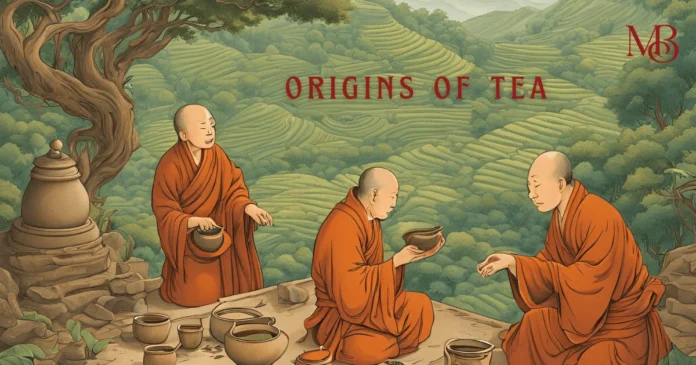Origins of Tea! Ah, tea! That soothing, steamy brew that’s become a ritual, a comfort, and a daily companion for billions of people worldwide. Whether you’re a die-hard chai aficionado, a green tea purist, or a lover of all things herbal, there’s something magical about the humble cup of tea. But have you ever stopped to think about how tea’s journey began? Let’s travel back over 5,000 years to ancient China, where the story of tea—full of legends, emperors, and a little bit of serendipity—first began.
Tea’s Legendary Beginning: An Emperor’s Happy Accident
The tale of tea’s history starts with none other than Emperor Shen Nong, an ancient Chinese emperor, herbalist, and all-around cool guy who lived around 2737 BCE. Shen Nong was known for his commitment to health, cleanliness, and the welfare of his people. Legend has it that one day, while the emperor was boiling water (as one does in the pursuit of cleanliness), a leaf from the Camellia sinensis plant floated into his pot.
Now, most of us would probably just pluck the leaf out, grumble about nature ruining our perfectly good water, and move on. But not Shen Nong. Instead, he allowed the leaf to steep, creating a golden-hued liquid that intrigued him enough to take a sip. The rest, as they say, is history—or more specifically, tea history.

That first sip? It must have been glorious because Emperor Shen Nong quickly realized that this new beverage was not only refreshing but also possessed rejuvenating qualities. Thus, the world’s love affair with tea was born—starting from one lucky leaf in the emperor’s pot.
Origins of Tea From Medicinal Drink to Cultural Staple
What began as a chance discovery quickly became a big deal in ancient China. Initially, tea was used for medicinal purposes. After all, if it was good enough for Emperor Shen Nong, it must have healing powers, right? People in ancient China believed tea could cure a range of ailments, from indigestion to lethargy, and it became an integral part of traditional medicine.
But tea didn’t stay confined to the doctors and healers for long. By the Tang dynasty (618-907 CE), tea drinking had morphed into an art form and a cultural phenomenon. The Chinese started hosting elaborate tea ceremonies, perfecting the craft of tea-making, and even writing entire books on the subject. The most famous of these is the Cha Jing (The Classic of Tea) by Lu Yu, a scholar who practically turned tea into a philosophy.
Tea was no longer just a drink—it was a symbol of Chinese culture, spirituality, and refinement.
Origins of Tea: From China to Japan and Beyond
As tea became a cornerstone of Chinese life, the origins of tea weren’t long before other cultures caught wind (or perhaps aroma) of this wondrous drink. Buddhist monks traveling between China and Japan in the 9th century played a key role in bringing tea to Japan. They believed tea helped with meditation and spiritual practice, offering clarity and focus—a kind of zen in a cup.
Tea quickly became embedded in Japanese culture, where it evolved into the famous Japanese tea ceremony, or chanoyu, a highly ritualized and artistic way of preparing and enjoying tea. The tea ceremony emphasizes mindfulness, harmony, and respect, qualities that reflect the deep philosophical roots tea planted in Japan.
By the 16th century, tea had made its way to Europe, carried by Portuguese and Dutch traders. It wasn’t exactly an instant hit; in fact, it took some time for tea to find its footing in the West. Europeans, accustomed to coffee, wine, and beer, initially viewed tea as an exotic curiosity. But once Queen Catherine of Braganza, the Portuguese wife of England’s King Charles II, made tea fashionable at court in the 1660s, it quickly became a staple of British high society. From there, it wasn’t long before tea drinking spread to the rest of Europe, eventually becoming a global phenomenon.
Tea and India: A Love Story Written in Leaves
While tea is often associated with China and Japan, India has also played a monumental role in the tea story. In fact, India is now one of the world’s largest producers of tea, thanks to—you guessed it— the British.
In the 19th century, British colonists decided they weren’t keen on relying solely on Chinese tea imports, so they began cultivating tea in India’s northeastern regions, particularly Assam and Darjeeling. The climate and soil were perfect for tea, and before long, India became the crown jewel of the British tea trade.
India gave the world masala chai, a spiced tea that blends black tea with cinnamon, cardamom, ginger, cloves, and other aromatic spices. Today, chai isn’t just a drink—it’s a way of life, providing comfort in every sip.
Quirky Tea Facts That Might Just Steep Your Interest
Enough about origins of tea—let’s get to the fun stuff! Tea has been around for over 5,000 years, which means it’s picked up some quirky trivia along the way. Here are a few tidbits to ponder the next time you’re sipping your favorite blend:
- Tea was once so valuable, it was used as currency! In ancient China, tea bricks (compressed blocks of tea leaves) were sometimes used as money. That’s right—tea was literally worth its weight in gold!
- Tea bags were invented by accident. In the early 1900s, an American tea merchant named Thomas Sullivan sent out samples of tea in small silk bags. His customers assumed the bags were meant to be dipped directly into hot water, and voila—the tea bag was born.
- There are over 1,500 varieties of tea! All tea comes from the same plant (Camellia sinensis), but different processing methods create different types of tea, from delicate white tea to robust black tea. Talk about variety!
- Tea can help you live longer. Studies have shown that regular tea drinkers tend to have lower rates of heart disease and may even live longer. So go ahead—brew that extra cup!
- Tea is the second most consumed beverage in the world. The only drink that beats tea in global popularity? Water! And let’s face it, water doesn’t even come with the delicious option of adding milk and sugar.
The Modern Tea Renaissance: From Traditional to Trendy
In today’s world, tea is more than just a hot drink—it’s a lifestyle. From trendy matcha lattes to iced bubble tea, tea has reinvented itself over the centuries to stay relevant. Health-conscious consumers flock to green tea for its antioxidants, while those in need of a pick-me-up opt for robust black teas like Earl Grey or Assam.
And let’s not forget about herbal teas. While technically not “true” teas (since they don’t come from the Camellia sinensis plant), herbal infusions like chamomile, peppermint, and rooibos have carved out their own niche in the tea world.
Tea’s ability to adapt, evolve, and remain deeply intertwined with culture and daily life is a testament to its enduring appeal. Whether it’s served in a delicate porcelain cup or a giant to-go mug, tea has proven it’s here to stay.
If you liked “Origins of Tea!” so far then you will also like: 10 Strange Traditions Around the World
Final Sip: Tea, Timeless and Ever Refreshing
From a fateful leaf in Emperor Shen Nong’s boiling water to the millions of cups brewed around the world each day, the 5,000-year origins of tea are nothing short of remarkable. It has crossed borders, cultures, and generations, becoming a beloved beverage in almost every corner of the globe. So, the next time you enjoy a steaming cup of tea—whether it’s green, black, white, or herbal—remember you’re sipping on a little piece of history. And doesn’t that just make it taste even better?
Now you now about the origins of tea, who’s ready for another brew? Read more on the culture page while sipping your cup of tea.


